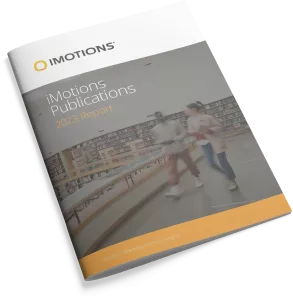-
Implicit and explicit liking of a snack with health- versus taste-related information
Despite extensive consumer testing during product development, healthy snacks often fail in the market. This indicates that other factors are at play besides what is traditionally being tested before product launch. The aim of the study was to examine how exposure to a snack with a health versus taste message affects perceived healthiness, expected tastiness, […] -
Visual attention to sustainability messages and self-reported willingness to pay for sustainable takeout and delivery packaging in Honduras
Recent changes in the consumption habits of the population suggest consumers have increased the number of purchases of take-out and livery food. This trend comes with unintended negative externalities to the environment, as it has resulted in increased plastic pollution due to single-use plastic food containers. Unfortunately, sustainable and eco-friendly alternatives tend to be more […] -
Expert gaze as a usability indicator of medical AI decision support systems: a preliminary study
Given the current state of medical artificial intelligence (AI) and perceptions towards it, collaborative systems are becoming the preferred choice for clinical workflows. This work aims to address expert interaction with medical AI support systems to gain insight towards how these systems can be better designed with the user in mind. As eye tracking metrics […] -
Utilizing Eye-Tracking in Advertising: Preliminary Findings
Eye-tracking research is steadily increasing, with emerging hypotheses about the connection between eye movements and cognitive processes in advertising contexts. This study aimed to utilize eye-tracking technology to explore how consumers perceive advertising appeals, particularly in distinguishing between the promoted product and the accompanying elements within an advertisement. The research sample included 35 students aged […] -
My money-My problem: How fear-of-missing-out appeals can hinder sustainable investment decisions
Cryptocurrencies (cryptos) have detrimental environmental effects due to their massive energy consumption. While several green crypto coins have been launched, the mainstream-environmentally unfriendly coins-still lead the market. In this study, we explore if influencer marketing, specifically fear-of-missing-out (FOMO) appeals, can contribute to promoting green crypto coin purchases to encourage sustainable investments. The results of five […] -
Prenatal affective cognitive training to reduce the risk of postpartum depression (PACT): study protocol for a randomized controlled trial
Background Postpartum depression (PPD) affects 30–50% of women with a history of previous depression or bipolar disorder and 8% of women with no history of depression. Negative cognitive biases in the perception of infant cues and difficulties with emotion regulation are replicated risk factors. Current interventions focus on detecting and treating rather than preventing PPD. The aim of this […] -
From E-Commerce to the Metaverse: A Neuroscientific Analysis of Digital Consumer Behavior
The growing interest in consumer behavior in the digital environment is leading scholars and companies to focus on consumer behavior and choices on digital platforms, such as the metaverse. On this immersive digital shopping platform, consumer neuroscience provides an optimal opportunity to explore consumers’ emotions and cognitions. In this study, neuroscience techniques (EEG, SC, BVP) […] -
The Face of Deception: How Your Mimicry Tells the True Story
Presentation Abstract:Objective: There are contested claims that communication receivers mimic communication senders less when senders are deceptive compared to truthful. Our studies evaluate a novel computer-based measure of facial mimicry to determine its potential to inform the debate. By examining the facial reactions of individuals receiving deceptive and truthful messages, we test whether this innovative […] -
Unveiling the power of video sentiment analysis for predicting advertising effectiveness: exploratory research on femvertising
This research challenges the conventional method of textual sentiment analysis in evaluating advertising effectiveness. We examined two distinct video ads for a cosmetics brand, employing video sentiment analysis to gauge their emotional impact on 35 female participants. This assessment was conducted using a self-reported questionnaire and a biometric platform integrating facial detection analysis (using Affdex […] -
Beyond negativity? A laboratory study on emotional responses to populist strategies on social media
This exploratory laboratory study analyzes emotional responses to two types of populist strategies on social media platforms. We focus on emotional responses to content expressing ordinariness (on Instagram) and victimhood (on TikTok), where the content creator is a right-wing populist leader who is unfavorably perceived by the respondents in the study. Thus, the study critically […]
Research Report 2024
In-depth look at the scientific landscape as powered by iMotions software, showcasing groundbreaking research and the impact of our tools in various scientific and industrial fields.

iMotions Science Resources
Looking for white papers, validation reports or research show casing iMotions Multimodal capabilities?
Share Your Research

850+ universities worldwide with an iMotions human behavior lab
73 of the top 100 highest ranked universities
710+ published research papers using iMotions
iMotions is used for some of the most interesting human behavior research studies carried out by top researchers around the world. Contact us to have your publication featured here.
The authors of these publications have used iMotions as a software tool within their research.
“Software should be cited on the same basis as any other research product such as a paper or a book; that is, authors should cite the appropriate set of software products just as they cite the appropriate set of papers” (Katz et al., 2020).
We therefore encourage you to cite the use of iMotions where appropriate.
How to cite iMotions
APA
iMotions (10), iMotions A/S, Copenhagen, Denmark, (2024).
Note: adjust the version and year where relevant.
5 Most Popular Blogs
Publications
Read publications made possible with iMotions
Blog
Get inspired and learn more from our expert content writers
Newsletter
A monthly close up of latest product and research news


